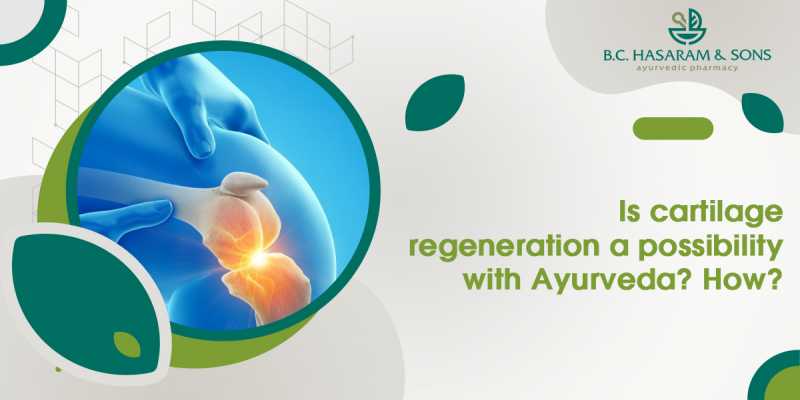
Ayurveda is a kind of Indian medicine that dates back to the 4th century BC. It promotes a healthy lifestyle by combining nutrition, exercise, and mindfulness meditation. For example, if you have arthritis, it may be good to take certain minerals and other supplements together with your current therapy.
These natural therapies might help alleviate some of your arthritis symptoms and prevent further development. However, cartilage regeneration is quite difficult with just consuming medicines but not impossible with Ayurveda.
As the cartilage that cushions the ends of the bones wears away, osteoarthritis (OA) is a long-term, degenerative disorder of the joints. Osteoporosis occurs when the bones rub against one another, resulting in a loss of mobility, stiffness, and irritation. However, traditional treatments for osteoarthritis usually concentrate on pain reduction and inflammation management, which have little influence on the disease’s natural progression.
For osteoarthritis, the most commonly given medicines are only modestly effective. Even more serious are the negative effects, which may even be life-threatening. It’s not uncommon for joint replacement surgery to be the last therapy for a debilitating joint.
One of the most frequent types of arthritis, osteoarthritis, may cause anything from mild pain to complete immobility. Any joint in the human body may be affected by arthritis, but the hands and weight-bearing joints, such as the knees, hips, and spine, are most often affected (usually in the neck or lower back). Pain and decreased mobility can have a profound effect both physically and emotionally on people with advanced osteoarthritis, limiting their ability to work, participate in social activities, and enjoy life.
Patients and medical experts are turning to alternative treatments like Ayurveda, an ancient healing technique, since traditional treatments are only moderately efficient and have the potential for adverse effects.
Boswellia
According to the research, the Ayurvedic herb Boswellia serrata, popularly known as Indian frankincense, has been shown to relieve joint discomfort and inflammation. A substance called leukotrienes is a crucial factor in the development of inflammation, and 5-lipoxygenase, a key enzyme in producing these chemicals, is blocked by Boswellia. In addition, osteoarthritis sufferers who took Boswellia, ashwagandha, turmeric, and zinc reported decreased joint discomfort and enhanced mobility and strength.
Turmeric
The ubiquitous spice in Asian cuisine, particularly in South and East Asia, is turmeric. In traditional Ayurvedic medicine, it is used orally and topically to treat a broad range of diseases linked to inflammation. It is also utilized. There is evidence that curcumin, the main element in turmeric, may disrupt the inflammatory cascade at three separate points by inhibiting lipooxygenase, cyclooxygenase, and phospholipase A2 enzymes. However, it may also protect the stomach from nonsteroidal anti-inflammatory drugs. Curcumin/turmeric seems to be a potential therapy for osteoarthritis, even though only a few studies back up this claim.
Ashwagandha
Ashwagandha, another Ayurvedic herb, has been shown to have anti-inflammatory properties. A 2007 study indicated that this herb’s extract inhibited the synthesis of pro-inflammatory chemicals. In addition, Ashwagandha’s anti-inflammatory properties were equivalent to hydrocortisone’s in one study.
Ginger
Ginger has also been shown to have anti-inflammatory properties. Ginger disrupts cyclooxygenase, an enzyme that creates inflammatory compounds in the body. According to some research, ginger may have a somewhat positive impact on knee OA. However, ginger’s use in osteoarthritis treatment needs more investigation.
Triphala
Osteoarthritis has been treated for thousands of years in India using the Ayurvedic herb Triphala. The three herbs that make up the Triphala formulary are: Amalaki, Haritaki, and Bidhitaki. Triphala’s botanicals, according to preliminary research, offer anti-inflammatory properties.
Guggulu
The herb Guggulu has been proven to be a powerful inhibitor of the enzyme NFKB, which governs the body’s response to inflammation. Guggulu resin extracts have been shown in a number of trials to reduce inflammation and edema in joints.
BC Hasarm’s Kesri Tailam
Kesri Tailam, an analgesic and anti-inflammatory, may be used to treat arthritis-related inflammation. It may also help strengthen tissues and ease joint and muscular pain. It has been used by many and given mind-blowing results!
Osteoarthritis may be treated using a variety of Ayurvedic remedies. Incorporating practices like yoga and meditation, as well as herbal remedies, are just a few ways to do so. These therapies provide the advantages of traditional medicine but without the considerable hazards. Our health and happiness may improve if we focus on correcting the underlying imbalances and harmonizing our body, mind and spirit.





